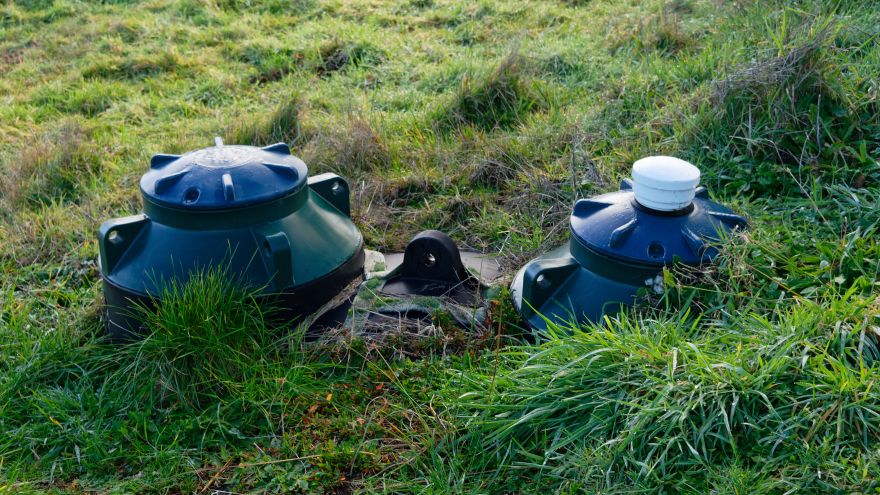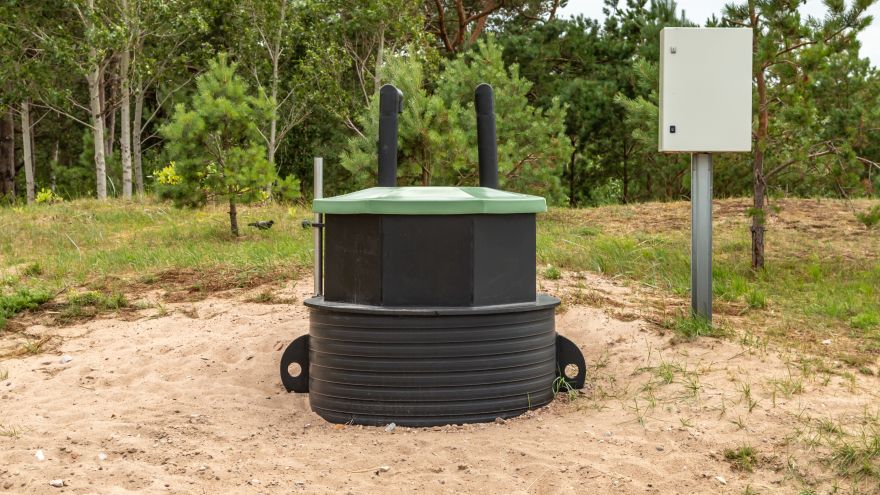A home sewage pumping station is a convenient and economical system for discharging waste from facilities that cannot be connected to the municipal sewage network. Are you planning to install it? Check what you need to remember.

From this article you will learn:
- What is a home sewage pumping station and how does it work?
- What to remember before installing it.
- What regulations govern its construction and use.
How does a home sewage pumping station work?
A home sewage pumping station is a self-service system responsible for transporting sanitary sewage from the building to the collective sewage system. It consists of a cover, a manhole (selected depending on the terrain) and a casing. The basic elements of every pumping station are:
- Septic tank (retention chamber) – the largest element of the sewage pumping station, on which the pumping system is based. The tanks are made of plastic, resistant to chemical compounds (usually high-density polyethylene PEHD, polyester resins, B45 reinforced concrete, polymer concrete).
- Submersible submersible pump ( the heart of the device) or their system.
- Gravity collector (feeder),
- A pipeline pumping sewage into a septic tank.
The process of removing waste from the facility is very simple. It can be described in 4 three steps:
- Sewage from the facility flows by gravity to the pumping station tank located at the lowest point of the sanitary installation.
- A submersible pump placed in the tank raises the sewage to the appropriate height.
- When the tank is full, the float switch installed in it, responsible for measuring the sewage level, automatically starts the forcing pump.
- The sewage flows through the pipeline straight to the septic tank, and the entire cycle can start again.
Check out the products for home sewage treatment plants in the Onninen offer
Household sewage pumping stations are installed where the building cannot be connected to the municipal sanitary network and where the tank cannot discharge sewage from the facility by gravity. Pumping stations do not require deep excavations, so they can be installed in areas with high groundwater levels. The system is convenient and cheap to use. Modern pumps have grinding mechanisms that prevent clogging.
What should you remember before installing a home sewage treatment plant?
The construction of a home sewage treatment plant should be preceded by analyzes related to the needs of users, including:
- pump installation location,
- pump power and capacity,
- type of casing (inside or outside the building; free-standing pump; for installation in the floor slab or ground).
However, in this article we assume that you have already completed similar stages (at least most of them). Therefore, we will focus on the formalities and regulations regarding the installation and use of the system.
Home sewage pumping stations – the most important regulations
 The normative act regulating the provisions related to the construction and use of a home sewage treatment plant is the Regulation of the Minister of Infrastructure of April 12, 2022 on the technical conditions to be met by buildings and their location. Some of the requirements are also specified in the Act of July 20, 2017 - Water Law, as well as several industry regulations.
The normative act regulating the provisions related to the construction and use of a home sewage treatment plant is the Regulation of the Minister of Infrastructure of April 12, 2022 on the technical conditions to be met by buildings and their location. Some of the requirements are also specified in the Act of July 20, 2017 - Water Law, as well as several industry regulations.
We will not quote the extensive content of these documents here. However, we will present the most important issues related to:
- necessary activities to be performed before the construction of the pumping station,
- minimum distances from its elements,
- introducing treated sewage into the environment.
Pursuant to Art. 29, section 1, point 3 of the Construction Law, to install a home sewage pumping station with a capacity of 7.5 m3/d per day (or a septic tank for liquid waste with a capacity of up to 10 m3/d), it is enough to report it to the district office. You also need to deliver there:
- document confirming ownership of the plot,
- design sketch,
- a map showing the location of the sewage treatment plant.
If the office does not raise any objections within 21 days, work can begin. The work may last up to 2 years and should be completed when the house is occupied.
From June 28, 2015, sewage pumping stations with a capacity of up to 7.5 m3/d can serve several single-family houses. However, if the sewage treatment plant is to be more efficient, there will be more formalities because the installation of such an installation requires a permit.
Before you start applying for it, check the Local Spatial Development Plan. If the plot can be connected to the sewage system, you will not receive a permit to build a sewage treatment plant.
Also remember that once you receive them, your installation will have to meet a number of specific regulations related to its legal construction and use.
Installation of a home sewage pumping station – regulations and principles of operation
According to the law, the installation must be distant from a residential building and other households so that the minimum distance from its doors and windows is 5 m. If there is a drinking water well (water supply well) on the plot, the tank body must be at least 5 m away from it. by at least 15 m, and the place of sewage discharge and infiltration - by at least 30 m. These distances apply to all water wells intended for human consumption. This means both those on the plot where the sewage treatment plant will be located and those on neighboring plots.
Other minimum distances for placing installation elements apply to:
- trees and other plants with an extensive root system – at least 3 meters,
- plot border, road and pedestrian route - min. 2 meters,
- water supply – min. 1.5 m,
- gas connection – usually at least 1.5, although the permissible range, depending on the date of construction of the connection, is 0.5–3.0 m,
- telephone cables – min. 1 m,
- electric cables – min. 0.8 m
Check out the products for home sewage treatment plants in the Onninen offer
Moreover, the sewage pumping station tank should be located so that a slurry tanker can periodically arrive to empty the structure. If this proves impossible, an alternative is to equip the tank with a suction port with a fireman's type connector. This will allow the vehicle to empty the container without having to travel.
If there is a risk that the home sewage treatment plant will generate a number of unpleasant odors (resulting from anaerobic sewage treatment processes), it is worth locating it away from places intended for recreation. If this is difficult, consider equipping the system with anti-odor filters or installing a hybrid biological treatment plant .
Another important issue is the disposal of treated sewage. This can be done to the land owned by the introducer (e.g. via an absorption well and drainage pipes ). The following conditions must be met:
- the amount of sewage cannot exceed 5 m³ per day,
- wastewater treatment should result in a reduction of pollutants of at least 20% for the BZT5 parameter (five-day biochemical oxygen demand) and at least 50% for the total suspended solids content,
- the place of sewage disposal must be separated by a layer of soil with a thickness of min. 1.5 m from the highest usable aquifer level of groundwater (this is an absolute condition).
 The second method is to discharge sewage directly into watercourses. However, this requires a water permit. The document specifies the expected parameters of treated sewage, its volume and method of disposal over a 12-month period. It also specifies the frequency with which they should be tested. The permit is obtained for a maximum of 10 years.
The second method is to discharge sewage directly into watercourses. However, this requires a water permit. The document specifies the expected parameters of treated sewage, its volume and method of disposal over a 12-month period. It also specifies the frequency with which they should be tested. The permit is obtained for a maximum of 10 years.
Construction of a home sewage pumping station from Onninen
You now know what to pay attention to before building a home pumping station. You will find a wide range of devices at the Onninen hydraulic wholesaler . Popular solutions include:
- BIO–DUO biological sewage treatment plant (1–6 PE) – a system worth attention, especially due to its high treatment stability: it is resistant to temporary energy shortages.
- The ONE2CLEAN–5 biological sewage treatment plant in SBR technology is characterized by high durability and capacity (750 liters of sewage per day), and its design (composition of two halves) allows you to reduce transport costs.
- Sewage treatment plant with infiltration chambers EPURECO4 (RLM4) 2100L KIT (superstructures with threaded cover, ST130 chambers) - a high-quality set that includes a septic tank with a biological filter, a superstructure, a distribution well (SL-RR), an infiltration chamber, a sewage pipe, a ventilator and sewage elbow.
- Sewage treatment plant with infiltration tunnels EPURBIO4 (RLM4) 2100L SET (superstructures with telescopic cover, GRAF300 tunnels) - a comprehensive set which, in addition to the well, pipes, settling tank, superstructure and ventilator, also includes infiltration tunnels (GRAF300 300 L)
Check out our offer and choose a solution dedicated to your needs!
Check out the products for home sewage treatment plants in the Onninen offer